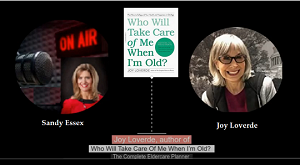What is the Greatest Risk for Retired Seniors?
October 1, 2019 | by Thomas Day

By far, the greatest risk for retired seniors, especially those who are advanced in age, is the need for long-term care services. U.S. Department of Health and Human Services projections estimate that 70 percent of Americans who reach the age of 65 will need some form of long-term care in their lives for an average of 3 years. (See HHS Administration on Aging website) Unfortunately, based on our 17 years of experience at the National Care Planning Council, and in dealing with thousands of aging seniors and their families, we conclude that most elderly people have failed to plan for long-term care even though many of them will eventually need it.
Long-term care services generally are provided for those who cannot function on their own without the help of another person. This might include assistance with activities of daily living such as the assistance with bathing, toileting, dressing, ambulating, transferring, dealing with incontinence or eating. It can also include assistance with other services provided to the disabled person such as shopping, cooking meals, providing transportation, paying bills, managing medications, answering the phone, performing household chores, providing companionship, providing supervision and so on.
If one were to ask an older person about his or her most important concerns there would naturally be a variety of different answers. But according to surveys frequently conducted among the elderly, the most frequent answers would include the following three principal concerns.
- Remaining independent in the home without intervention from others
- Maintaining good health and receiving adequate health care
- Having enough money for everyday needs and not outliving assets and income
Although aging seniors are definitely worried about the need for long-term care it is seldom a priority. Probably this is a result of the distaste most people have in contemplating a future of poor health, disability and eventual death. They don’t want to think about it. On the other hand, because of the frequency of occurrence and the fact that it is often in the news, everyone is concerned about having his or her house burn down or having a car accident or getting an illness or ending up in the hospital. People do plan for these risks by purchasing insurance, setting money aside or providing instructions to family members. Yet, it is our experience that virtually no one plans for the more frequently occurring and more devastating risk which is the need for long-term care.
With the need for long-term care the older person loses everything that is important to his or her lifestyle which could include any or all of the following:
- Loss of independence
- loss of good health and lack of functioning due to disabilities
- dissipation of remaining assets and lack of adequate income due to care costs
No other late-life event can be as devastating to the lifestyle the elderly are so concerned about maintaining. No wonder many elderly care recipients withdraw, become angry and suffer from severe depression.
Hardly a day goes by at the National Care Planning Council that we fail to receive countless requests from distraught family members who are dealing with long-term care needs for their elderly loved ones. In most cases the requests revolve around the issue that retirement savings have been completely eaten up due to long-term care costs. And in most cases there is not enough income to pay for outside care services. Most of these folks are in panic mode and don’t know where to turn for help. They are looking for sources of funding or assistance in providing care.
The cost of care can be enormous. Fortunately, family caregivers, friends and community organizations such as churches provide most of the care services in this country at no cost. But at some point these non-paid volunteers become overwhelmed and cannot handle the scope of the services needed for many long-term care recipients. Or for some needing care there is no family or community support for providing that care. This means that commercial paid services need to be used. These commercial services can include home care companies, assisted living facilities and nursing homes.
According to the Administration on Aging website, 65% of people receiving care services are in their homes and 35% are in assisted living or nursing homes. Of those receiving homecare, approximately 40% are receiving some level of commercial services at an out-of-pocket cost and 60% are receiving unpaid care. It is likely that for those paying out-of-pocket for home care, family caregivers or others are also supplementing by providing additional unpaid care as well.
Genworth Insurance Company provides an annual survey on the costs of home care, assisted living and nursing homes across the country in various cities and regions. The latest survey from 2018 reveals that the median cost of US care services for a single individual is the following:
Homemaker Services – $4,004 a month
Home Health Aides – $4,195 a month
Assisted Living – $4,000 a month
Nursing Home Semi Private Room – $7,441 a month
Nursing Home Private Room – $8,365 a month
But these are the median costs, which means half of the care recipients are paying more than that amount and half are paying less than that amount. In some areas of the country the expense of these services can be double of what the median amounts are. In the Northeast urban areas we are seeing assisted living costs of around $7,000 to $9,000 a month and nursing home costs of around $12,000 to $14,000 a month. Just three years of these kinds of out-of-pocket expenses would wipe out $280,000 to $500,000 of retirement savings, depending on the facility. Long-term care is typically not what retirement savings were intended to pay for.
It isn’t just that long-term care can eat up retirement savings and can reduce surviving spouses to poverty. It can be detrimental to family caregivers as well. The stress of caregiving over a long period of time leads to depression, development of diseases and even early death of the caregiver. Often, caregivers are so focused on what they are doing and have entirely so isolated themselves from family and friends that they don’t recognize the serious harm they are dealing to their own personal health.
My goal is to help you create a plan to mitigate those consequences and help you think through what plan is in your best interest!
IF YOU DON’T OWN A POLICY, EMAIL or CALL ME SO WE CAN DISCUSS HOW YOU CAN STILL GET IN ON THE MAJOR SAVINGS.
IF YOU OWN A POLICY, we can determine if this plan would be an advantageous option for you!
Sandy Essex,
CLTC Long Term Care Planning Advisor
847.695.6690
Visit us at www.BestLtcAdvice.com
CLICK HERE to see the COST Of CARE IN YOUR AREA
To send me a Secured Email click here!
We take care of tomorrow, so you can focus on today!
I look forward to helping you and any friends or family members that have not planned.






